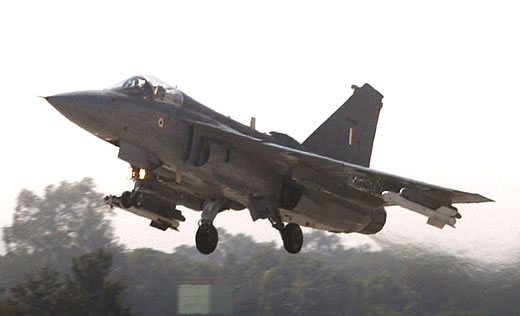

On January 10, the Indian Air Force (IAF) formally announced the country’s new, indigenous fighter, the Tejas Light Combat Aircraft (LCA) was received ‘initial operational clearance’ (IOC). Once its entire flight envelope and weapons are cleared for operation, the new aircraft, developed for the past 20 years, will equip the first fighter squadron operating 20 aircraft in about two years.
Tejas, is the first fighter aircraft ever to be developed by India and was designed by the Bangalore based Aeronautical Development Agency (ADA) under the Defence Research and Development Organization (DRDO). Final assembly of the aircraft and flight testing are performed at Hindustan Aeronautics (HAL) plant at Bangalore. Originally launched in 1983, India’s Light Combat Aircraft project expanded far beyond the projected schedule and cost, with an estimated budget of Rs 560 crore (about $5.6 billion). Sofar about US$3.8 billions were invested in the program.

When it reaches full operational capability, the current Tejas is claimed to be comparable with Sweden’s Gripen, the Chinese-Pakistani J-17 Thunder and the South Korean T-50 jets. But some in the Indian Air Force reluctantly relate to their newest plane as ‘not more than an upgraded MiG-21’. But Tejas is a ‘work in progress’, and, if the ADA roadmap will progress as expected, Tejas Mark II could become a ‘4+ generation’ fighter. Once completed, and given support from the cabinet, the aircraft could be produced in large numbers if the Indian Air Force will select the Tejas to fulfill its plans for 200 fighters, replacing the MiG-21s being withdrawn from operational use, after several decades of service. However, at present the Air Force considers buying only 83 Mk-II aircraft, hence the likely production lot to about half of the projected volume. The Indian Navy is still committed to the program, expecting 40+ aircraft to replace its Sea Harrier FRS-51 and two-seater Sea-Harrier T-60.
The long Way to Indigenous design production
It took the Indian government 14 years to agree on the plan to develop an indigenous aircraft administration. The design team operating under ADA control took 18 more years to mature the design into a flying prototype, and additional 10 years have passed since its first flight, until the Tejas has reached IOC. Beside the Indian nature of moving at a slow but steady pace, part of the complexity of this program was, that ADA was mandated with a huge challenge – to develop a fighter aircraft consisting entirely of Indian technology. While the end product is not nearly 100% Indian, ADA is still formally committed to full localization of the program, with the introduction of domestically designed engine fitted into a fully locally produced aircraft by 2014.
Taking a more pragmatic view of the program DRDO is preparing an alternative path, with 60% level of Indian content. VK Saraswat, DRDO chief, explained that complete indigenous design and production would instead end up with the unit cost going up several times more than the present Rs180 crore apiece (about US$42 million).
The IAF plans to base the first squadron in Bengaluru and eventually position Tejas in Sulur in the south Indian state of Tamil Nadu. The first squadron is expected to become operational in 2013, along with full operational certification of the aircraft.
The IAF’s does not consider indigenous design and production as its utmost priority, and insists that the new fighter should be rated ‘fourth generation’ status for full acceptance – which is now scheduled for December 2012. The next version, Tejas Mk II will be integrated with Indian systems utilizing foreign technologies, adhering to India’s strict technology transfer rules. The GE-414 engine is one such example. The first flight of the Tejas Mk II is expected in 2014 followed by planned service entry in 2016.
The development of the engine clearly demonstrates how India has met this ambiguous challenge. As part of this program, India was already developing an indigenous engine known as Kaveri, which experienced major hurdles throughout its development. In 2004, after realizing their Kaveri jet engine could derail the entire program, India selected the General Electric F404-GE-IN20 engine as an interim solution for the first production batches, powering the first 40 production aircraft. In 2010, following an international tender that included the Eurojet, M88 and F-414, the General-Electric GE-414 was selected to power 99 of the next phase “Tejas Mk II” variants. This engine is also required to power the naval version. The prototype of the Indian Navy Tejas two-seat variant NP-1 rolled out in July 2010, the Indian Navy has a requirement of 50 such aircraft. The two-seater trainer variant prototype flew in November 2009.

In the area of flight controls, the airframe design and construction ADA managed to overcome the obstacles associated with computing and materials – elements made of carbon fiber composite make over 40% of its weight.
The ‘glass cockpit’ comprises three 5×5 Multi-Function Displays (MFD) and DASH helmet mounted display and sight (HMDS). The level of indigenous design and production is also evident in the avionics suite. Out of a total of 35 major avionics components and line-replaceable units (LRUs), only three involve foreign systems. The MFDs are imported from Sextant in France and Israel’s Elbit Systems, which also provides the HMDS. Israel’s Rafael also provides the Rafael “Litening” targeting pod for the aircraft. Other avionic systems developed in India include self-protection systems and radar. Yet both systems were not ready for production, necessitating integration of foreign systems in the first production aircraft. These include derivative of the Elta EL/M-2032 radar and self protection system from Elisra.




















